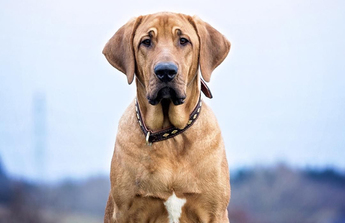Grooming the Tosa is fairly straightforward due to his short coat, though his large size means it’s a big job. A bath every three months (or when he’s dirty) in a mild vet-approved dog shampoo is a good idea. Brush his sleek coat with a natural bristle brush or mitt once a week. Use coat conditioner/polish to brighten the sheen. Wipe out his facial wrinkles with a damp cloth and dry them thoroughly to help prevent skin fold infections.
Check the Tosa’s ears every week and clean them if they look dirty. Trim toenails once a month. Regular tooth brushing with a soft toothbrush and doggie toothpaste will help keep the teeth and gums healthy. It is essential to introduce grooming to the Tosa when he is very young so he learns to accept the handling and fuss peacefully.
Tosas are, by nature, a rather calm breed, though even low-energy breeds need some exercise in order to maintain a healthy weight and get mental stimulation. Options for exercise could include run time in the backyard, preferably fenced, or being taken for walks.
Exercise can also come in the form of indoor activities like chasing a ball rolled along the floor or learning new tricks. Certain outdoor activities like hiking or retrieving balls can provide a good outlet for expending energy, too. Training for dog sports like agility, obedience, and rally can also be a great way to give your dog exercise.
As a large breed, the Tosa should be offered a dog food diet formulated for large-breed dogs. Because this breed develops slowly you may need to keep him on a puppy diet for longer than a year to make sure he has enough fuel to foster healthy growth and development.
Any diet should be appropriate to the dog’s age (puppy, adult, or senior). Some dogs are prone to gettingoverweight, so watch your dog’s calorie consumption and weight level.
Treatscan be an important aid in training, but giving too many can cause obesity. Learn about whichhuman foodsare safe for dogs, and which are not.Check with your vet if you have any concerns about your dog’s weight or diet.Clean, fresh water should be available at all times.
The Tosa is generally a healthy breed as long as breeders follow responsible breeding practices to prevent passing on genetic conditions. As a large breed dog, the Tosa is prone to developing certain musculoskeletal issues like hip dysplasia and they may also be prone to gastric torsion, or bloat.
The Tosa is an intelligent breed and typically easy to train. This breed learns quickly and can be started with training as early as 8 weeks of age.
Socialization is incredibly important for this breed due to its dog fighting background – you should take your dog to puppy training classes starting from 10 to 12 weeks of age.
Positive reinforcement-based training methods are recommended for this breed but you need to maintain a firm and consistent hand in training so the dog knows who the boss is.











